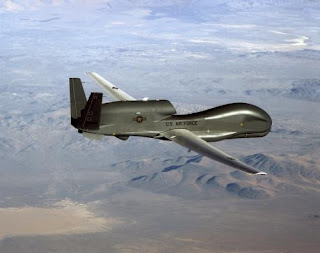Northrop Grumman has challenged the US military's decision to park existing RQ-4 Global Hawk Block 30s in usable storage and terminate production.
The imagery- and signals intelligence-collecting variant of the high-altitude, long-endurance unmanned aircraft system could be cancelled as part of the fiscal year 2013 budget cuts proposed by the Pentagon on 26 January.
The proposed cuts, meanwhile, create uncertainty about the programme's future as South Korea and NATO are poised to sign orders for different Global Hawk variants.
Northrop has launched a multimedia campaign to block the proposed cuts, despite the US military's long-standing concerns about the type's cost, reliability and sensor performance.
"We think it's a great product," said George Guerra, Northrop's vice-president of high-altitude, long-endurance systems. "It's done a lot of great things."
However the US Air Force, which has received 11 of the 14 RQ-4 Block 30s already on order, was unimpressed after deploying the aircraft last year after the Japan earthquake and during the Libyan rebellion.
The key test for the USAF was whether the Block 30 would be a cheaper and more capable intelligence platform than the 65-year-old Lockheed U-2, scheduled to retire in 2016.
On 27 January, USAF Chief of Staff Gen Norton Schwartz said the Global Hawk system had not proved to be cheaper to operate than the U-2. "And in many respects, the Global Hawk Block 30 system is not as capable from a sensor point of view, as is the U-2," he added.
As of July 2011, operating the U-2S fleet cost $2,830 per flight hour, versus more than $6,710 for the RQ-4A/B, as stated in the air force's total ownership cost (AFTOC) database obtained by Flightglobal.
Northrop, however, considers the USAF's cost comparisons "a little flawed", Guerra said. The company's analysis suggests the air force recently shifted some overhead costs for the U-2 fleet over to the RQ-4, which artificially lowered the Global Hawk fleet's affordability, he added.
The AFTOC records show the U-2S fleet's cost per flight hour declined abruptly by 32% within two years after the RQ-4 entered the database in 2010. However, the U-2S was still always cheaper to operate, peaking at less than $4,180 per flight hour in 2009, or 37% less than the RQ-4 last year.
Guerra also said that complaints about the Global Hawk's primary sensor - the Raytheon enhanced imagery surveillance system - are outdated. "There were a couple of improvements made to the sensor very recently," he said.
Schwartz did not complain about the RQ-4's reliability statistics, although a report last year by the USAF's operational testing office was highly critical. During initial operational test and evaluation, the RQ-4's mission capability rate averaged about 41%.
However, the Global Hawk's reliability "has actually improved significantly in the short span of a year", Guerra said. The mission capability rate for deployed RQ-4s now averages about 83%, he added.


No comments:
Post a Comment